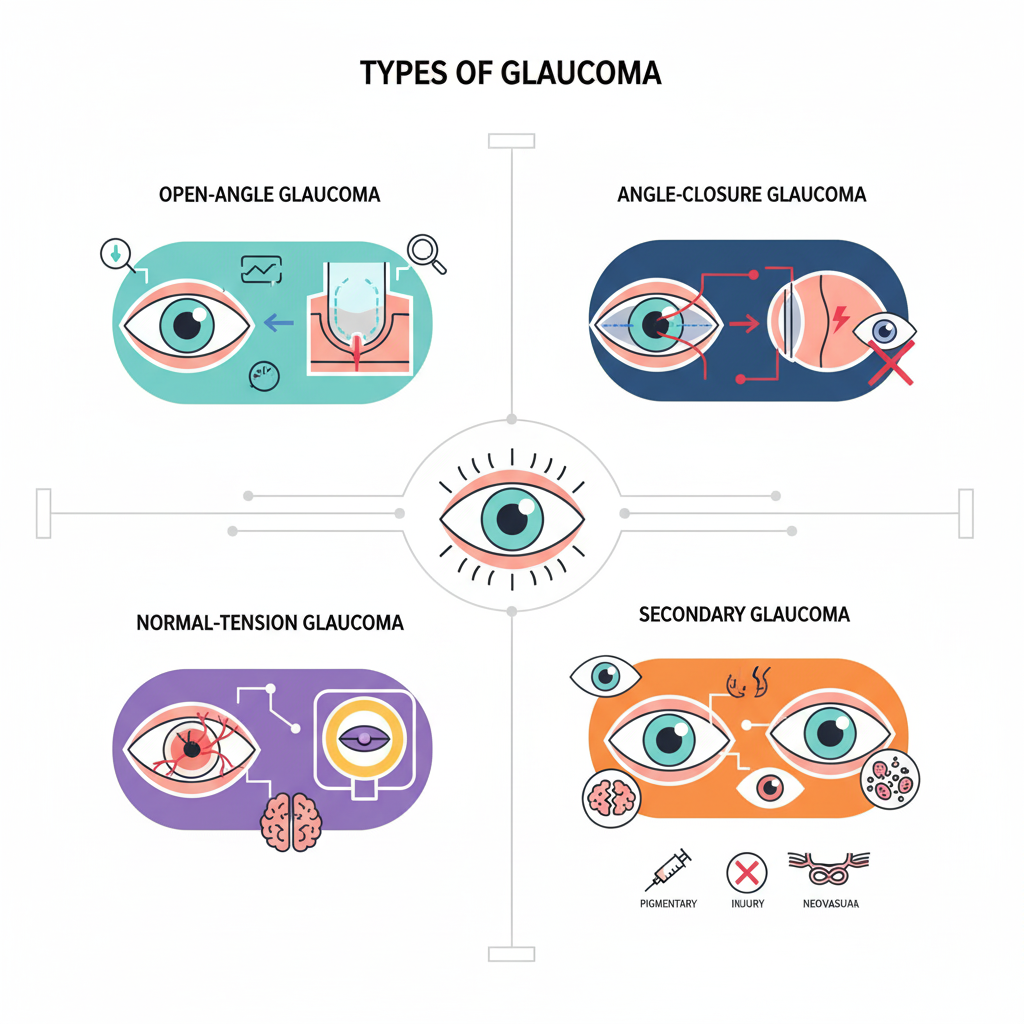Glaucoma is a serious, lifelong eye condition that has earned the name “silent thief of sight” because it can permanently damage your vision before you even notice glaucoma symptoms. At Burjeel Day Surgery Center – Al Ain, we understand the urgency of early detection. Our Ophthalmology Department is equipped with cutting-edge technology and specialists dedicated to providing advanced glaucoma treatment.
What is Glaucoma? (Glaucoma Meaning)
Glaucoma refers to a group of eye diseases that damage the optic nerve – the nerve that carries visual information from the eye to the brain. Over time, this damage leads to loss of vision, sometimes progressing to blindness if left untreated.
The term “glaucoma” comes from the Greek word glaukos meaning “bluish-green” or “grey” – a reference originally to the colour of the diseased eye. Clinically, the disease often occurs because fluid within the eye fails to drain properly, causing a build-up of pressure (intra-ocular pressure, IOP) which then damages the optic nerve.
In short, when you see the phrase glaucoma eye or “glaucoma in the eye,” it means your eye’s internal drainage and pressure system is under threat, and the optic nerve is being harmed.

Glaucoma Symptoms – Recognizing the Signs
One of the biggest challenges with glaucoma is that early symptoms may be minimal or absent, which is why it is often called the “silent thief of sight.” In practical terms, this means:
- With the most common type, Open‑angle glaucoma, the drainage angle of the eye remains open, but the internal valve system becomes less efficient. Vision loss begins at the periphery (side vision) and often isn’t noticed until it’s advanced.
- Typical symptoms (when they appear) include: missing some letters when reading, difficulty seeing in low light, trouble with peripheral vision (for example missing stair-risers), or issues driving at night.
- In other types of glaucoma (for example angle-closure types) there may be sudden symptoms: eye pain, redness, blurred vision, halos around lights, nausea or vomiting.
Because symptoms can appear only after damage has started, the key message is: regular eye check-ups with an ophthalmology specialist matter.
Glaucoma Causes – What Leads to Glaucoma?
Let’s talk about glaucoma causes. In many cases, the exact trigger for glaucoma is not known, but there are recognized mechanisms and risk factors to be aware of:
Mechanism
- In a healthy eye, fluid (aqueous humour) is produced, circulates and drains through the trabecular meshwork at the angle between the cornea and iris. When drainage is impaired, fluid builds up, raising intraocular pressure which then damages the optic nerve.
- In open-angle glaucoma, the drainage angle appears open, but internal resistance builds up (often gradually) causing slow pressure elevation and optic nerve damage.
- There are also mechanisms beyond pressure, including vascular and neuro-degenerative processes that damage the optic nerve even when pressure is “normal.”
Risk-factors & Causes
Some of the established risk-factors and causes include:
- Elevated intraocular pressure (ocular hypertension) – one of the strongest risk factors.
- Age – risk rises with advancing age.
- Family history of glaucoma.
- Certain medical conditions: e.g., diabetes, high blood pressure, and vascular diseases.
- Eye injuries, inflammations, or use of certain medications (for example, long-term steroids) that can damage drainage systems.
At Burjeel Day Surgery Center – Al Ain, our ophthalmologists review these risk factors during your comprehensive eye exam so we can detect glaucoma early, before significant damage occurs.
Types of Glaucoma
Glaucoma is categorized based on the specific anatomical feature causing the drainage issue. The four main types of glaucoma are:

Open-Angle Glaucoma (Primary Open-Angle Glaucoma)
- This is the most common type.
- The drainage angle in the eye is open, but the internal meshwork (trabecular meshwork) is clogged or not draining efficiently.
- The drainage angle in the eye is open, but the internal meshwork (trabecular meshwork) is clogged or not draining efficiently.
- It leads to a slow, gradual rise in eye pressure and is typically.
Angle-Closure Glaucoma (or Narrow-Angle Glaucoma)
- Less common, but can cause a sudden, painful rise in eye pressure.
- The drainage angle itself becomes blocked, often by the iris (the colored part of the eye).
- This is a medical emergency requiring immediate attention to prevent rapid, permanent vision loss.
Normal-Tension Glaucoma (Low-Tension Glaucoma)
- This is a surprising form where the optic nerve is damaged despite the intraocular pressure (IOP) remaining within the normal range.
- The exact cause is unknown, but it may be related to poor blood flow to the optic nerve.
- Key Feature: Optic nerve damage occurs even with normal eye pressure readings.
Secondary Glaucoma
- This type occurs as a complication of another medical condition, injury, medication, or eye surgery.
- It results from a known cause that blocks the eye’s drainage system, causing pressure buildup.
- Key Causes: Eye trauma, advanced cataracts, diabetes, inflammation (uveitis), or steroid use. Treatment involves addressing both the glaucoma and the underlying condition.
Glaucoma Treatment – What Are the Options?
The good news: while glaucoma cannot yet be cured in the sense of restoring lost vision, effective treatment can halt or significantly slow progression if detected early. At Burjeel Day Surgery Center – Al Ain, our ophthalmology specialist team provides the full spectrum of glaucoma care.
Here’s a breakdown of treatment options:
1. Medications (Eye Drops)
One of the first-line treatment approaches is the use of prescription eye drops. These medications work by either decreasing the production of intraocular fluid or improving its outflow, thereby lowering IOP and protecting the optic nerve. Compliance is critical: consistent use as prescribed is vital to preserving vision.
2. Laser Treatments & Minimally Invasive Procedures
If eye-drops alone are not sufficient or appropriate, our ophthalmology specialists may recommend laser procedures or minimally invasive glaucoma surgery (MIGS) to improve drainage or reduce pressure in a less invasive way. (Example: for open-angle glaucoma, the drainage pathway may be enhanced.)
3. Surgical Treatment
In more advanced cases or when other treatments don’t achieve desired pressure control, more conventional surgery may be required—such as a trabeculectomy or drainage-device placement. These aim to provide an alternate drainage route for the aqueous fluid.
4. Monitoring & Long-Term Care
Because glaucoma is a chronic condition, ongoing monitoring is essential. Regular visits to your ophthalmology specialist allow us to measure your intraocular pressure, assess the optic nerve, evaluate your vision and visual field, and adjust treatment when required. Remember: vision lost to glaucoma cannot yet be recovered, so the emphasis is on prevention of further loss.
5. Lifestyle & Supportive Measures
While medical and surgical care form the core of glaucoma treatment, there are additional support measures you can adopt: ensuring your general health (blood pressure, blood sugar), avoiding eye-injury risk, staying up to date with eye exams, and following your treatment plan closely. Our team will advise you on these during your visit.
Why Choose Burjeel Day Surgery Center – Al Ain?
At our center, our ophthalmology specialist team is committed to providing patient-centered, advanced care. Here’s what sets us apart:
- Expertise: Our ophthalmology specialists are trained and experienced in diagnosing and managing glaucoma, including complex and early-stage cases.
- State-of-the-art diagnostics: We utilize modern imaging and visual field testing to detect glaucoma and monitor progression long before major symptoms emerge.
- Comprehensive treatment offerings: From medications to laser and surgical interventions, we provide the full spectrum of glaucoma care under one roof.
- Patient-focused care and education: We believe in empowering patients with knowledge about what glaucoma means for them, how to recognize symptoms, and how treatment works.
- Convenience: Located in Al Ain, our facility offers day-surgery conveniences, efficient appointments and follow-up care – designed to minimize patient burden while maximizing outcomes.
Frequently Asked Questions (FAQs)
Yes – because open-angle glaucoma often causes no obvious symptoms until vision loss is advanced, regular eye exams with an ophthalmology specialist are crucial.
“What is glaucoma” refers broadly to the disease group of optic-nerve damage processes. “Open angle glaucoma” is the most common subtype, where the drainage angle is anatomically open but drainage is impaired.
Unfortunately, once vision is lost due to optic-nerve damage, it cannot be restored. The goal of treatment is to prevent further loss. That’s why early detection and management are so important.
If you are over 40, have a family history, or other risk factors (e.g., diabetes, high-blood pressure), you should have a comprehensive dilated eye exam annually or as recommended by your ophthalmology specialist.
Protect Your Eyes from Glaucoma
Glaucoma is a serious eye condition – but when detected early and managed properly by skilled ophthalmology specialists, the risk of significant vision loss can be substantially reduced. Knowing what is glaucoma, understanding its meaning, recognizing glaucoma symptoms, being aware of glaucoma causes, and being informed about glaucoma treatment all contribute to a proactive approach to eye health.
If you are concerned about glaucoma, or simply need your routine eye check-up, we invite you to visit us at Burjeel Day Surgery Center – Al Ain. Our team is ready to provide compassionate, advanced care tailored to your needs. You don’t have to wait until symptoms appear – the sooner glaucoma is caught, the better your outcome.
Contact us today to schedule your consultation with one of our Ophthalmology Specialists and take control of your eye health.








